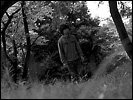Now, I…
- Year
- 2008
- Original title
- Ima Boku wa
- Japanese title
- 今、僕は
- Director
- Cast
- Running time
- 87 minutes
- Published
- 5 February 2009



by Dean Bowman
When it screened at London's Raindance film festival in 2009, newcomer Yasutomo Chikuma's documentary drama Now, I... proved to be nothing short of a revelation. Although a work of naturalistic fiction the film delivers its images in a manner that is so utterly convincing that it constantly fools you into thinking you are watching a documentary, heralding the emergence of a talented young filmmaker. Shot on a mere $5000, it also perhaps hints at a new generation of indie filmmakers in Japan willing to deal with serious social problems. By writing, directing, and acting in the film Chikuma demonstrates a confidence that is the mirror opposite of the film's subject; the chronically withdrawn Satoru Suzuki, a twenty-year-old boy who lives with his mother.
Spending his days sleeping and playing video games, Satoru is, Chikuma claims, an example of one of the thousands of so called NEET in Japan (an acronym that stands for the rather clumsy phrase Not engaged in Education, Employment or Training; a term that originally comes from England, and has crept into Japanese usage). He could of course also represent the better-known condition termed 'hikikomori', a form of extreme social withdrawal and depression explored in a rather fantastical fashion by Kiyoshi Kurosawa's brilliant psychological horror film Pulse. Whatever you want to call the condition on display, however, the important thing is that Now, I... adds an extremely personal dimension to all the sociological terminology and textbook statistics. As painful as Satoru is to those around him, and as frustrating as he undoubtedly is to the viewers, the film never once suggests we should consider him a lost cause. It does this, as all great 'documentaries' undoubtedly should, by observing rather than judging its subjects.
Chikuma, who modelled his protagonist on a friend, achieves the film's tremendous level of identification by using an extremely subjective camera. We are first introduced to Satoru as he ventures bleary-eyed into the kitchen on one of his rare foraging trips, the camera wobbling in close up over his shoulder, almost like the kind of third-person point of view you are given in many video games. Satoru constantly avoids eye contact with those around him and so shots of the back and sides of his head with its long scruffy mop of hair dominate the film. Only rarely is he not the subject of the image, indeed those rare moments are the ones in which he escapes from the adults who are desperately trying to lure him out of his shell and into society - namely his long suffering mother and her friend Mr. Fujisawa, who finds Satoru a job at a local winery.
When Mr. Fujisawa turns up spontaneously one morning with his rather unwelcome offer of employment, Satoru follows him passively. He ignores Fujisawa on the long awkward car journey, ignores his co-workers (therefore rejecting any chance to extend his social circle) and performs the duties assigned to him at the factory with a stubbornness that might be considered rebellious if it were driven by anything other than pure reluctance - but ultimately Satoru is neither stubborn nor rebellious, but simply cripplingly shy. Fujisawa even takes Satoru to look out over the beautiful vineyard and points out the office in an effort to situate him within his new environment. It is a generous moment, but one that characteristically fails to register as Satoru continues to shoe gaze.
But, as must inevitably happen to us all, one day Satoru's life suddenly changes forever. A phone call comes which he answers with a series of grunts and in the next scene makes his way to the hospital where his mother has been taken. He sits mute at her bedside before storming out. Perhaps he is incapable of dealing with his emotions or perhaps he simply doesn't want to acknowledge them at all? We'll never know for sure because Chikuma plays his part with the brilliant inscrutability of a Bresson character, though fortunately without the religious undertones. Indeed at the screening Chikuma cited Bresson as well as the Dardenne brothers as key influences, and he certainly does them proud by lending a highly personal edge to their distinct brand of ascetic realism.
The next time Satoru sits beside his mother a white sheet covers her face. Although he is certainly not equipped to deal with life without his mother's self-sacrificing support, when Mr. Fujisawa calls around to offer his help he simply becomes the target for Satoru's frustrated anger. But Fujisawa doesn't give up and one day, when he sees Satoru walking down the street, he leaves his car to chase him, only to be knocked over himself. The interesting thing here is that we are not shown this tragedy directly - as the camera is still floating around Satoru's shoulder. It is only when he turns around to look that we see Fujisawa lying on the ground. As with the cut to Satoru sitting next to his dead mother it is a brilliant piece of elliptical editing reminiscent of Ozu's propensity for skipping over dramatic moments. We don't witness these events because Satoru doesn't. In a clever aesthetic strategy Chikuma is putting us in his protagonist's shoes; forcing us to feel as isolated and excluded from the narrative as Satoru does from life.
Satoru seems to be cursed to inflict misery on those few who care for him, something that lends the film a poignantly tragic dimension and some much needed drama. Although the fact that Satoru's character is so seemingly resistant to change threatens the film's ability to offer a sense of closure, when the climactic scene finally comes it is both devastatingly poignant and completely enigmatic, reminiscent of the extraordinary ending of Tawainese director Tsai Ming Liang's masterpiece Vive L'Amour (1994). Understated, downbeat and perfectly judged, Now, I... is surely the work of a great new filmmaker.